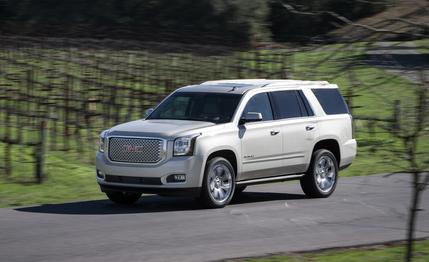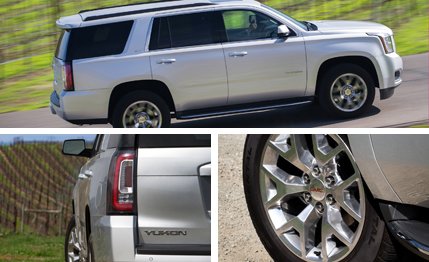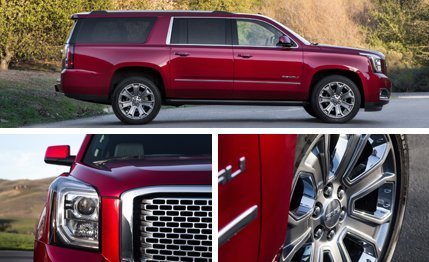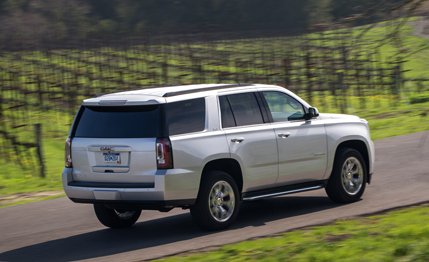
 First Drive Review
First Drive Review
It’s no secret that the GMC Yukon and Chevy Tahoe are more than fraternal twins. They are essentially mechanically identical, and even their metallic skins are virtually the same, sharing doors, rear quarters, and roof. That intimate relationship continues with the introduction of the 2015 Yukon.
Both models get handsome new sheetmetal with a strong horizontal character line, a flatter and more raked windshield, and new high-tech lighting units. But the Yukon’s three-bar grille, square headlights, and smoother hood make it easy to distinguish from the Chevrolet. And the top-of-the-line Denali gets a distinctive egg-crate grille that is more sculpted and three-dimensional than the last generation’s.
Slide into the Yukon, and you’re treated to a new dashboard that curves and bulges in all the right ways and places the central LCD in a high position where it’s easy to read. The controls are conveniently arrayed, and there’s extensive use of wood trim, soft plastics, and attractive stitching. The Denali comes standard with the highest level of trim, and more than half of Yukon buyers opt for that version.


One reason to choose the Denali is the standard 6.2-liter V-8, which has now been upgraded with direct fuel injection and an 11.5:1 compression ratio. That raises output to 420 horsepower and 460 lb-ft of torque—similar to the output of the base C7 Corvette. We estimate that this V-8, coupled to GM’s Hydra-Matic 6L80 six-speed automatic, cuts the 0-to-60 time from 7.1 to about 5.6 seconds. Fuel economy on the EPA city and highway cycles is up by 1 and 3 mpg on both rear-drive and 4WD versions.
Non-Denali Yukons share the upgraded 5.3-liter V-8 with the Chevy Tahoe. It now makes 355 horsepower and 383 lb-ft and gets about one extra mpg on all the tests. Expect this version to accelerate about as quickly as the 6.2-liter in the previous Denali.
All versions of the new Yukon benefit from larger rear doors, which make it easier to get into the second and third rows of seats. Those seats have been redesigned to make them slightly more comfortable and spacious, although adults consigned to the third row still won’t find much happiness during a long drive.


But your baggage will, because the second and third rows now fold completely flat, rather than leave the third row sitting in the luggage compartment like a flat steamer trunk. This was achieved by making the seats thinner and adding a roughly six-inch-thick platform to the luggage area. As on the previous model, you can get power flip and fold for the second-row seats, but they must be manually unfolded. However, you can now get power operation to fold and unfold the third-row chairs.
The downside to this upgrade is a reduction in luggage space. The thick platform cuts total luggage volume behind the first row by 14 cubic feet to 95, but in fairness, the previous version’s larger figure could only be achieved if you completely removed the heavy rearmost seats. Behind the third row, capacity drops from 17 to 15 cubic feet. However, there is some additional storage space for small items such as cameras and shoes beneath the raised floor.
With power-adjustable pedals and a power tilting-and-telescoping steering wheel available, the Yukon should fit the vast majority of drivers. The infotainment system accepts more voice commands than before, including reliable destination entry. It even has text-to-voice Siri operation with an iPhone.
On the road, the 2015 Denali feels impressively solid and composed. Improved door seals, acoustical laminated front glass, and active noise cancellation have made the interior extremely quiet under all conditions. The 6.2-liter V-8 feels strong and produces a subdued, but pleasing, snarl when flogged. Even the “small” 5.5-liter V-8 is noticeably friskier than before. Maximum towing capacity ranges from 8500 pounds for a two-wheel-drive Yukon to 8100 for a 4WD Yukon Denali.


All versions of the Yukon we drove felt tauter and more controlled than their predecessors, particularly the Denali, which comes standard with magnetic-ride-control shock absorbers. Although you never forget that you’re piloting three tons and 17 feet of truck, the Yukon and the Yukon Denali continue to respond accurately even when you push them.
The flip side is a ride that is not so plush. In fact, the Denali feels particularly unfiltered, although that perception might have been partly caused by the optional 22-inch wheels with their 45-series tires. You’ll see what we mean if you take one for a test drive in the pothole-ravaged Midwest.
Still, the powertrain improvements are solid, the utility of the flat cargo floor will be appreciated, the reduction in noise levels is worthwhile, and the interior and exterior redesigns are attractive. For Yukon and Denali fans, the new models will likely be worth the upgrade.